Mera Peak Expedition
The Mera Peak Expedition is a challenging and exhilarating mountaineering adventure located in the Khumbu region of Nepal. Mera Peak, standing tall at 6,476 meters (21,247 feet), is one of the highest trekking peaks in the country and offers breathtaking panoramic views of some of the world's highest mountains, including Mount Everest, Lhotse, Makalu, and Cho Oyu.
The expedition typically begins with a scenic flight from Kathmandu to Lukla, followed by a trek through picturesque Sherpa villages, dense forests, and remote valleys. As you ascend, you gradually acclimatize to the altitude, allowing your body to adapt to the thin air.
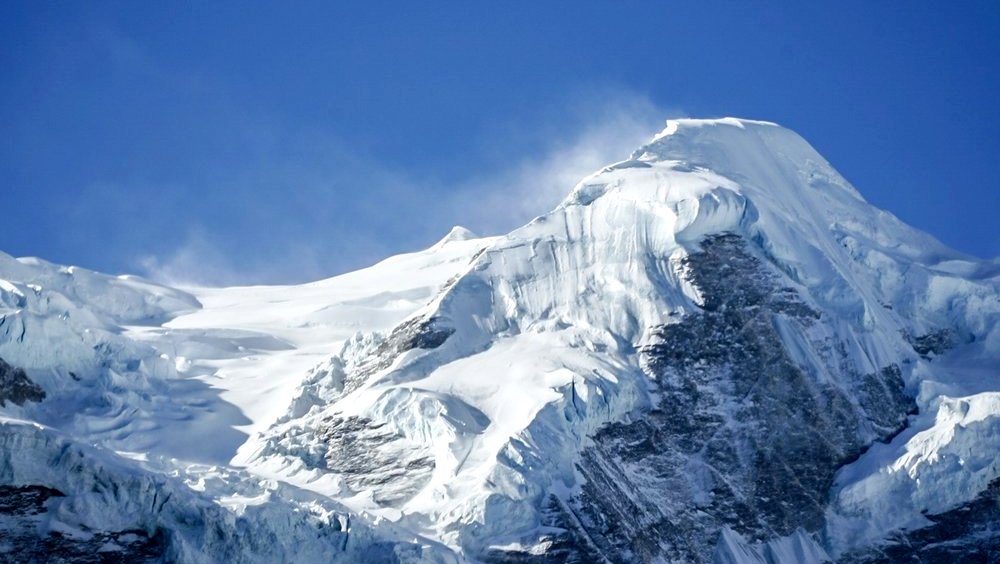
The route to Mera Peak takes you through stunning landscapes, including the Hinku Valley, where you'll encounter pristine glaciers, snow-covered peaks, and alpine lakes. The climb itself requires technical skills and a good level of physical fitness, as you will traverse steep slopes, negotiate crevasses, and use basic mountaineering equipment like crampons and ice axes.
Reaching the summit of Mera Peak is an incredibly rewarding experience. On a clear day, you'll be rewarded with awe-inspiring views of the surrounding Himalayan giants, as well as a sense of accomplishment and a deep connection to the mountain environment.
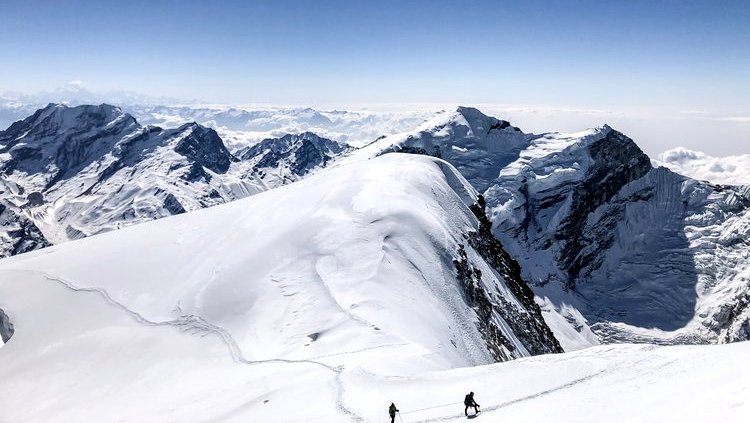
The Mera Peak Expedition typically takes around 18 to 20 days, allowing for proper acclimatization and ample time for the climb. It is often led by experienced guides and Sherpa climbers who provide support, and guidance, and ensure safety throughout the journey.
Whether you're an experienced mountaineer or seeking your first high-altitude adventure, the Mera Peak Expedition offers an unforgettable experience in the heart of the Himalayas, combining the thrill of climbing with the awe-inspiring beauty of the Nepalese mountains.
History of the Mera Peak Expedition
The history of Mera Peak expeditions dates back to the mid-20th century when mountaineers began exploring the Himalayas in Nepal. Mera Peak, located in the Everest region, gained recognition as a popular trekking peak due to its accessibility and stunning landscapes. In the 1950s, mountaineer Jimmy Roberts surveyed the area during the British Mount Everest Reconnaissance Expedition, sparking initial interest in Mera Peak as an adventure destination.
The first successful ascent of Mera Peak occurred on May 20, 1953, when a French team led by Marcel Jolly reached the summit. Following the route from the Mera La pass, the team conquered the peak, marking a significant milestone in the history of Mera Peak expeditions. This achievement attracted mountaineers from around the world and established Mera Peak as a sought-after destination for adventurers.
Since then, Mera Peak has continued to entice climbers with its breathtaking vistas and exhilarating climb. The peak offers a non-technical ascent, making it accessible to both experienced mountaineers and those seeking their first high-altitude adventure. The history of Mera Peak expeditions showcases the enduring allure of the Himalayas, where climbers can challenge themselves while being rewarded with awe-inspiring natural beauty and a sense of accomplishment upon reaching the summit.
Highlights of the Mera Peak Expedition
Mera Peak Expedition offers an amazing combination of natural beauty and cultural heritage to explore and learn. Here are the highlights of the Mera Peak expedition:
- Breathtaking views of the world's highest peaks, including Mount Everest, Lhotse, Makalu, and Cho Oyu.
- Diverse and stunning landscapes, from lush forests to high alpine meadows and glacial moraines.
- Immersion in Sherpa culture, with visits to traditional villages and ancient monasteries.
- A challenging but non-technical climb that offers a sense of achievement and the opportunity to push one's limits.
- Scenic flight to Lukla and trekking through remote and beautiful landscapes.
- Acclimatization stops to adapt to high altitude gradually.
- A true adventure experience that combines exploration, trekking, and mountaineering.
- Interactions with warm and welcoming local communities.
- Spectacular sunrises and sunsets over the Himalayan peaks.
- A chance to experience the serenity and natural beauty of the Khumbu region.
Routes for the Mera Peak Expedition
The Mera Peak Expedition offers several routes that climbers can choose based on their preferences, experience level, and time availability. Here are the main routes for the Mera Peak Expedition:
Standard Route (Mera La and Southeast Ridge)
Base Camp (Khare): Khare serves as the base camp for the Mera Peak expedition on the standard route. It is located at an altitude of approximately 5,045 meters (16,486 feet) in the Hinku Valley. The khare base camp provides basic facilities and serves as a hub for acclimatization and preparation for the climb.
High Camp: On the standard route, there is no specific "High Camp" before the summit push. Instead, climbers usually establish a Summit Camp at a higher elevation near the Mera La pass. The exact location of the Summit Camp can vary depending on the conditions and the judgment of the expedition leader.
Summit Camp: The Summit Camp is established at a suitable location closer to the Mera La pass, which is a high point on the route. It is typically set up to minimize the distance and elevation gain on the summit day. Climbers stay at the Summit Camp for a short period before making the final push for the Mera Peak summit.
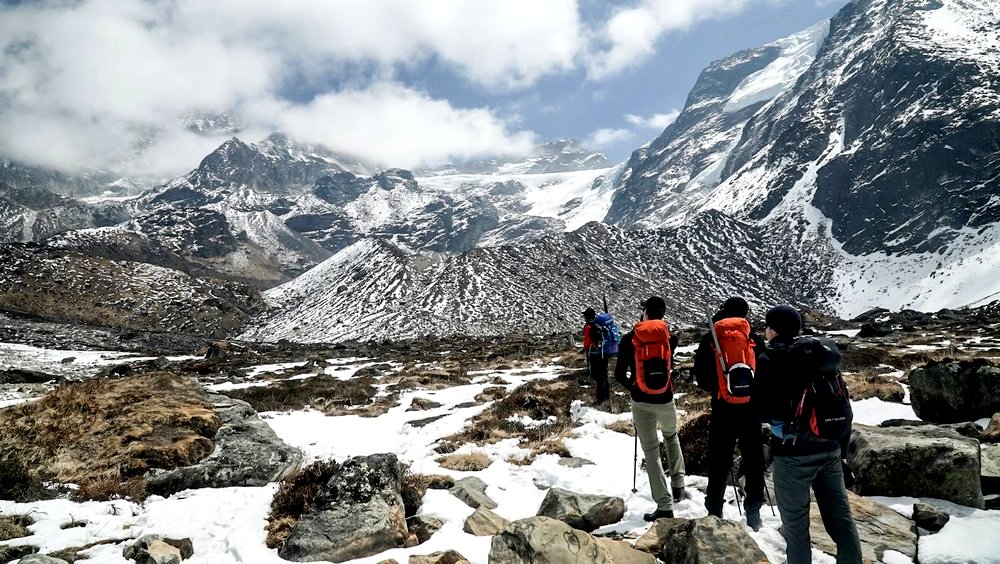
Mera Peak via Zatrwa La Pass
Base Camp: The base camp for the Mera Peak expedition via Zatrwa La Pass is typically established at a location called Khote or Kothe. It is located at an altitude of around 3,600 meters (11,811 feet) in the Hinku Valley. Khote serves as the starting point for the trek and provides a comfortable resting place for acclimatization before ascending further.
High Camp: After leaving Khote, climbers trek towards a higher camp known as Tangnang or sometimes referred to as Tashing Ongma. Tangnang is situated at an altitude of approximately 4,350 meters (14,271 feet) and serves as the high camp for this route. Climbers stay at Tangnang to further acclimatize and prepare for the summit push.
Summit Camp: Unlike the standard route, there is no specific designated summit camp for the Mera Peak via Zatrwa La Pass. After leaving Tangnang, climbers continue their ascent towards Mera La Pass, which stands at an elevation of around 5,415 meters (17,766 feet). The climbers establish a temporary camp in the vicinity of Mera La, referred to as the Summit Camp. This camp is set up to minimize the distance and elevation gain on the summit day and to provide a resting point before the final push to the Mera Peak summit.
Mera Peak via Amphu Laptsa Pass
Base Camp (Khare): Khare serves as the base camp for the Mera Peak expedition via Amphu Laptsa Pass. It is located at an altitude of approximately 5,045 meters (16,486 feet) in the Hinku Valley. The Khare base camp provides a starting point for acclimatization and serves as a hub for climbers to prepare for the challenging Amphu Laptsa Pass and the Mera Peak ascent.
High Camp: After leaving Khare, climbers trek towards a higher camp known as the Amphu Laptsa High Camp. This camp is established at an elevation of around 5,800 to 6,000 meters (19,029 to 19,685 feet), depending on the specific conditions and the judgment of the guiding team. The high camp is set up near the base of the Amphu Laptsa Pass, and climbers stay here to further acclimatize and prepare for the pass crossing.
Summit Camp: After crossing the Amphu Laptsa Pass, climbers establish a summit camp on the Hongu side of the pass. The exact location of the summit camp can vary depending on the specific conditions and the judgment of the expedition leader. The summit camp is set up at an elevation of approximately 6,100 to 6,300 meters (20,013 to 20,669 feet) and serves as a resting point before the final push to the summit of Mera Peak.
Mountain Views seen during the Mera Peak Expedition
During the Mera Peak expedition, climbers are rewarded with stunning mountain views in the Everest region of Nepal. Mera Peak itself offers a spectacular vantage point, providing panoramic vistas of several notable peaks. Here are some of the mountain views seen during the Mera Peak expedition:
Mount Everest: Mera Peak is situated in the Everest region, offering an excellent vantage point to admire the grandeur of Mount Everest. Climbers can witness the iconic summit of Everest and its surrounding glaciers from various viewpoints during the expedition.
Lhotse: Lhotse, the fourth-highest mountain in the world, is located in close proximity to Mera Peak. Climbers can enjoy breathtaking views of Lhotse's impressive pyramid-shaped peak, as well as its icy slopes and surrounding ridges.
Makalu: Makalu, the fifth-highest mountain in the world, can be seen during the Mera Peak expedition. Although not as close as Everest or Lhotse, Makalu's majestic presence adds to the scenic beauty of the region. Its distinct summit and glacier-clad slopes create a captivating sight.
Cho Oyu: Cho Oyu, the sixth-highest mountain in the world, is another prominent peak visible during the Mera Peak expedition. Its massive size and glaciated terrain provide a stunning backdrop to the surrounding landscape.
Kanchenjunga: While not as close as the other peaks mentioned, on clear days, climbers may catch glimpses of Kanchenjunga, the third-highest mountain in the world. It's snow-capped summits and rugged ridges offer a captivating view.
In addition to these prominent peaks, there are numerous other mountains, valleys, and glaciers that contribute to the awe-inspiring scenery during the Mera Peak expedition. The Everest region is renowned for its majestic Himalayan vistas, and climbers undertaking the Mera Peak expedition are treated to a visual feast of towering mountains and dramatic landscapes.
How Difficult is the Mera Peak Expedition?
The difficulty of the Mera Peak Expedition can vary depending on several factors, including the chosen route, weather conditions, personal fitness, and prior mountaineering experience. Climbing Mera Peak requires careful preparation and an understanding of the challenges involved.
One of the main challenges of the Mera Peak Expedition is the high altitude. The summit stands at an elevation of 6,476 meters (21,247 feet) above sea level. Climbers will experience thinner air, lower oxygen levels, and a greater risk of altitude-related illnesses such as acute mountain sickness (AMS). Proper acclimatization is crucial to mitigate these risks and allow the body to adjust gradually to the increasing altitude. Climbers must be prepared for slow and steady ascent rates, rest days for acclimatization, and be able to recognize and respond to symptoms of altitude sickness.
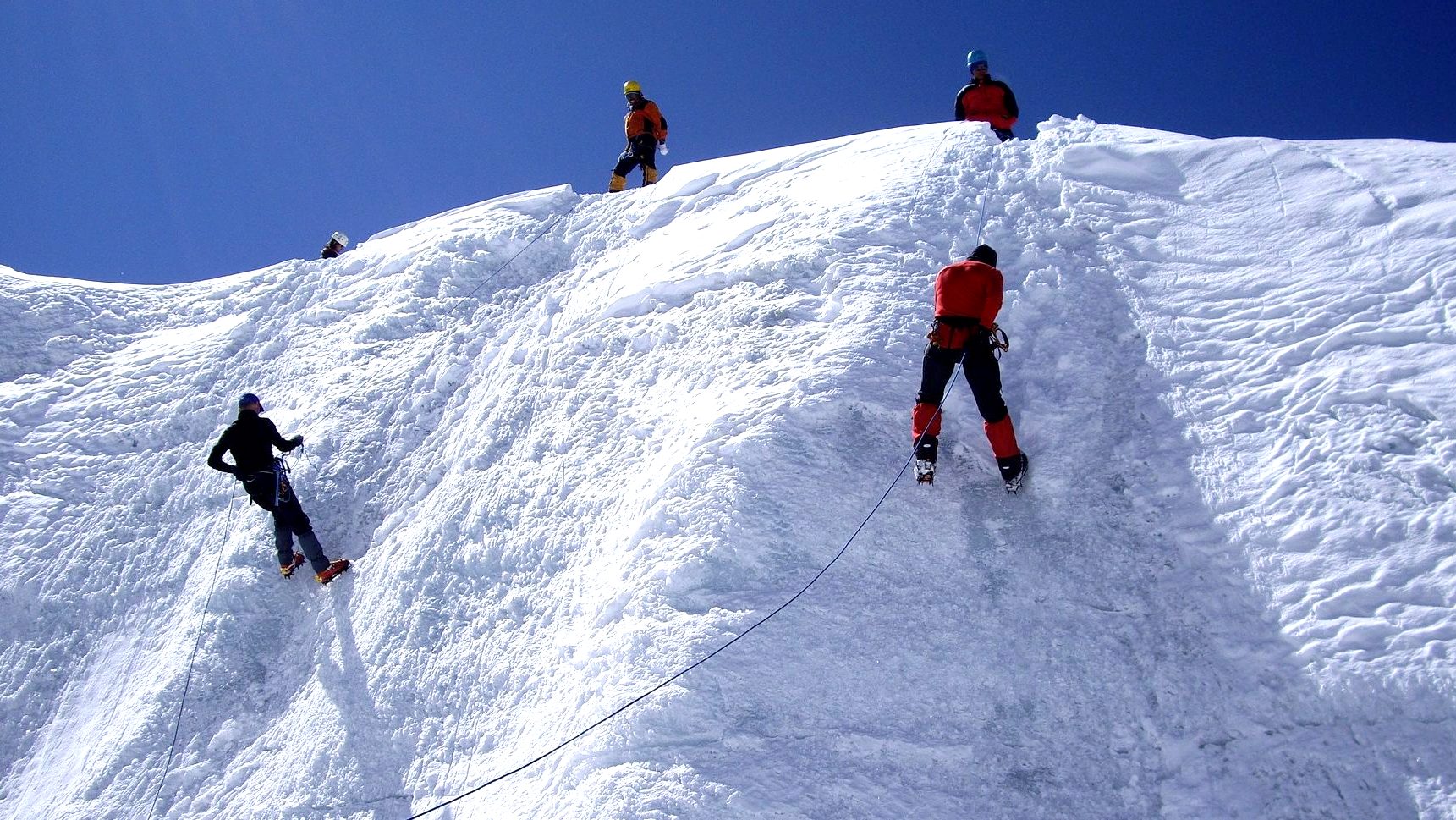
Physical fitness is another important aspect of the expedition. While technical climbing skills are not required, climbers should have a good level of cardiovascular endurance, strength, and stamina. The trek to Mera Peak involves several days of hiking through rugged terrain, steep ascents, and potentially challenging weather conditions. Prior trekking experience, especially at high altitudes, can be beneficial in preparing for the physical demands of the expedition and the climbing section of Mera Peak involves traversing glaciers and ascending steep snow slopes. Basic mountaineering skills such as the use of crampons, ice axes, and ropes are necessary for safety. Climbers should be comfortable with these techniques and have prior experience or training in glacier travel and self-arrest.
Additionally, the weather conditions in the Himalayas can be unpredictable and harsh. The expedition may encounter cold temperatures, high winds, snowfall, and limited visibility. Climbers must be prepared with appropriate clothing, equipment, and the ability to adapt to changing weather conditions.
While the Mera Peak Expedition poses challenges, with proper preparation, training, and guidance from experienced Sherpa guides, it is a feasible goal for climbers with previous trekking experience and strong determination. The reward of reaching the summit, taking in the breathtaking panoramic views, and the sense of accomplishment make the challenges worthwhile for those seeking a memorable adventure in the Himalayas.
How to prepare for the Mera Peak Expedition
To prepare for Mera Peak Climbing, focus on physical fitness through regular exercise, including cardio and strength training. Gain hiking and climbing experience, learn about climbing equipment and practice mountaineering techniques. Mentally prepare by researching the challenges, developing a positive mindset, and practicing relaxation techniques. Invest in quality gear, plan for altitude acclimatization, and stay hydrated. Consider hiring a guide or joining a group, obtaining necessary permits, and arranging logistics. Learn first aid and carry a well-stocked kit. Prioritize safety and have appropriate travel insurance. Seek professional advice for personalized guidance.
Permits for the Mera Peak Expedition
To undertake the Mera Peak Expedition, you need to obtain certain permits. Here are the permits required for the Mera Peak Expedition:
TIMS Card (Trekkers' Information Management System): All trekkers, including climbers heading to Mera Peak, need to obtain a TIMS card. This card helps in maintaining a record of trekkers and ensures their safety and security. The TIMS card can be obtained through a registered trekking agency or the Nepal Tourism Board.
Sagarmatha National Park Permit: Mera Peak lies within the Sagarmatha National Park, a UNESCO World Heritage Site. Therefore, climbers must obtain a Sagarmatha National Park Permit. This permit is aimed at conserving the natural and cultural heritage of the region. It can be obtained at the entrance gate of the park in Monjo or through a registered trekking agency in Kathmandu.
Climbing Permit: A climbing permit is required specifically for ascending Mera Peak. This permit is issued by the Nepal Mountaineering Association (NMA). It is important to note that climbing permits are subject to certain fees and regulations set by the NMA. Climbers are advised to contact the NMA or a registered trekking agency in Nepal for detailed information regarding the climbing permit process and fees.
It's worth mentioning that permit requirements and fees can vary, and it is important to stay informed about the latest regulations before planning your expedition.
Best Season For Mera Peak Expedition
While the spring and autumn seasons are considered the best times for the Mera Peak Expedition, it is possible to climb the peak during other seasons as well. Here is an overview of all the seasons for the Mera Peak Expedition:
Spring Season (March to May)
This is the prime season for climbing Mera Peak. The weather is generally stable, with clear skies and mild temperatures. The spring season offers good visibility, blooming rhododendron forests, and vibrant landscapes. It is an excellent time for a successful summit attempt.
Base Camp: During the daytime, temperatures can range from around 0°C to 10°C (32°F to 50°F). At night, temperatures can drop to around -10°C to -5°C (14°F to 23°F).
High Camp: Daytime temperatures can range from -5°C to 5°C (23°F to 41°F), and nighttime temperatures can drop to around -15°C to -10°C (5°F to 14°F).
Summer/Monsoon Season (June to August)
The monsoon season brings heavy rainfall and cloud cover to the Everest region, including the Mera Peak area. The trails can become slippery and unstable due to rain, making trekking and climbing more challenging. The risk of landslides and avalanches is higher during this season. It is generally not recommended to attempt the Mera Peak Expedition during the monsoon season.
Base Camp: Daytime temperatures at the base camp can range from around 10°C to 15°C (50°F to 59°F) and nighttime temperatures can drop to approximately 5°C to 10°C (41°F to 50°F).
High Camp: Daytime temperatures at the high camp can range from around 5°C to 10°C (41°F to 50°F) and nighttime temperatures can drop to approximately 0°C to 5°C (32°F to 41°F).
Autumn Season (September to November)
Another popular season for the Mera Peak Expedition, autumn brings stable weather, clear views, and moderate temperatures. The post-monsoon period offers dry conditions and is characterized by vibrant landscapes. The autumn season attracts a significant number of climbers and trekkers.
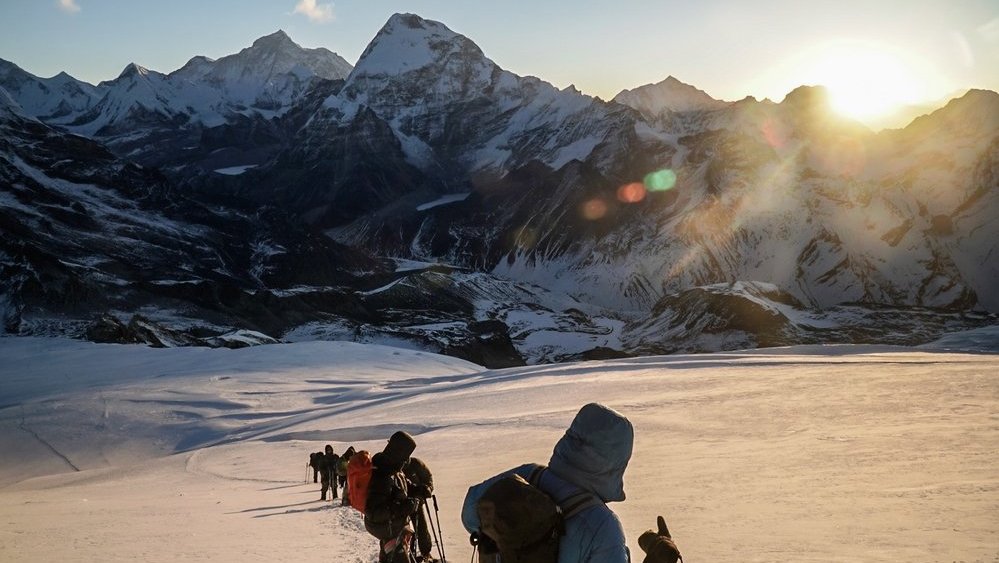
Base Camp: Daytime temperatures at the base camp can range from around 5°C to 15°C (41°F to 59°F). Nighttime temperatures can drop to approximately -5°C to 0°C (23°F to 32°F).
High Camp: Daytime temperatures at the high camp can range from -5°C to 5°C (23°F to 41°F), and nighttime temperatures can drop to around -10°C to -5°C (14°F to 23°F).
Winter Season (December to February)
Climbing Mera Peak during winter is possible but challenging. The weather is very cold, with temperatures dropping well below freezing. Snowfall and strong winds are common, which can increase the difficulty of the climb. The days are shorter, and visibility may be reduced. Winter climbing requires advanced mountaineering skills and experience in extreme cold conditions.
Base Camp: During the daytime, temperatures at the base camp can range from around -5°C to 5°C (23°F to 41°F). Nighttime temperatures can drop significantly, ranging from around -20°C to -10°C (-4°F to 14°F).
High Camp: Daytime temperatures at the high camp can range from -10°C to 0°C (14°F to 32°F), and nighttime temperatures can drop further, ranging from around -20°C to -15°C (-4°F to 5°F).
Weather plays a crucial role in the Mera Peak Expedition, impacting climbers' safety and the overall experience. The conditions can vary greatly throughout the year. Climbing during the season requires careful preparation and specialized gear. Trekking and climbing routes can become slippery and unstable. Regardless of the season, it is essential to stay updated with weather forecasts and consult experienced guides for the most accurate and current information. Proper gear, adequate training, and flexibility in planning are crucial to ensure a safe and successful Mera Peak expedition.
Accommodation and Meals During The Mera Peak Expedition
Accommodation
Tea Houses: Along the trekking route to Mera Peak, there are tea houses or lodges available in various villages. These provide basic accommodation facilities such as private or shared rooms with beds, blankets, and sometimes solar-powered hot showers. The quality of amenities may vary, with more basic facilities at higher altitudes.
Tented Camps: As you ascend to higher altitudes, especially during the high camp and summit camp stages, tented camps are set up. These camps provide temporary accommodation in high-altitude wilderness areas and typically include sleeping tents and dining tents.
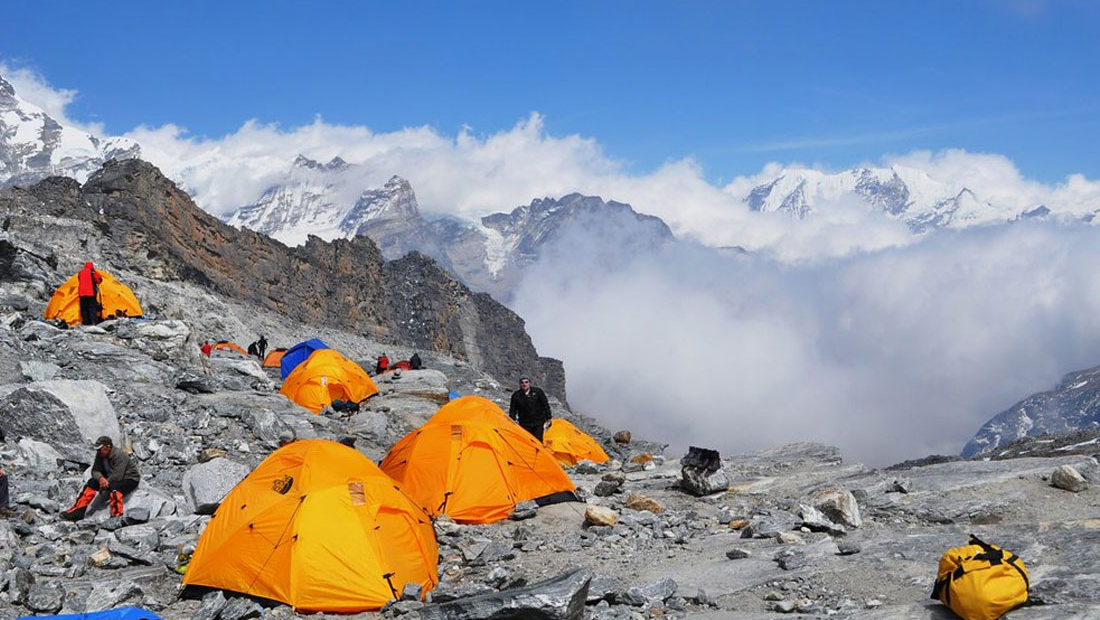
Meals
Tea Houses: Tea houses serve meals that include a variety of local and international dishes. You can expect options like dal bhat (a traditional Nepali dish of lentils, rice, and curry), noodles, pasta, soups, vegetables, eggs, bread, and tea or coffee. The availability of menu items may become more limited as you reach higher altitudes.
Tented Camps: During the high camp and summit camp stages, meals are prepared and served by the expedition team. These meals are typically catered and include a variety of nutritious food items to support climbers during the demanding ascent.
It's important to note that accommodation and meal facilities become more basic and limited as you ascend to higher altitudes. The availability of amenities can also vary depending on the season and the specific route taken. It is advisable to choose a reputable trekking company such as Luxury Holidays Nepal which provides experienced guides, porters, and proper logistics to ensure comfortable accommodation and well-prepared meals throughout the expedition.
Travel Insurance for the Mera Peak climbing
When planning to climb Mera Peak, it is highly recommended to have travel insurance that specifically covers mountaineering activities. Here are some key considerations for travel insurance:
- Coverage: Ensure the policy explicitly covers mountaineering and high-altitude activities, including Mera Peak Climbing.
- Emergency Evacuation: Verify that the insurance policy includes provisions for emergency medical evacuation from remote and high-altitude areas.
- Medical Expenses: Confirm coverage for medical expenses related to accidents or altitude sickness treatment.
- Trip Cancellation and Interruption: Consider a policy that covers trip cancellation or interruption due to unforeseen circumstances.
- Gear Coverage: Check if the policy provides coverage for the loss, theft, or damage of climbing gear.
- Exclusions and Limitations: Read the policy's terms and conditions, including any exclusions and limitations specific to mountaineering activities.
- Emergency Assistance Services: Look for a policy that offers 24/7 emergency assistance services.
- Documentation: Keep copies of your travel insurance policy, emergency contact numbers, and necessary documentation during the climb.
Remember to carefully assess your insurance needs and choose a policy that provides appropriate coverage for your Mera Peak Climbing adventure. It's advisable to consult with insurance providers who specialize in adventure or mountaineering activities to find the most suitable coverage for your specific requirements.
Checklist for the Mera Peak Expedition
Here's a checklist for the Mera Peak Expedition:
Clothing
- Base layers (thermal tops and bottoms)
- Insulated jacket or down jacket
- Waterproof and windproof outer shell
- Trekking pants
- Fleece or softshell jacket
- Warm hats and gloves
- Hiking socks and thermal socks
- Gaiters
Footwear
- Sturdy and waterproof trekking boots
- Crampons (with compatible boots)
- Trekking sandals or comfortable camp shoes
Climbing Equipment
- Mountaineering boots
- Climbing harness
- Ice axe
- Crampons
- Helmet
- Ascender and descender
- Carabiners
- Prusik loops
- Ropes (if not provided by the trekking agency)
Backpack and Bags
- Large backpack (60-80 liters) for carrying personal gear and equipment
- Daypack (20-30 liters) for daily essentials during the trek
- Duffel bag or waterproof bag for porters to carry
Sleeping Gear
- Four-season sleeping bag rated for sub-zero temperatures
- Sleeping pad or mat for insulation and comfort
Personal Hygiene and First Aid
- Toiletries (toothbrush, toothpaste, soap, etc.)
- Hand sanitizer and wet wipes
- Personal medications and a basic first-aid kit
- Diamox (altitude sickness medication) if recommended by a doctor
- Sunscreen and lip balm with high SPF
Climbing Accessories
- Sunglasses with UV protection
- Headlamp with extra batteries
- Trekking poles
- Water bottles or hydration bladder
- Water purification tablets or filter
- Snacks and energy bars
Miscellaneous
- Map and compass
- Whistle for emergencies
- Camera and extra batteries
- Power bank for charging electronic devices
- Trekking permits and necessary documents
- Cash for additional expenses (tips, snacks, etc.)
Remember to pack light and prioritize essential items. It's also important to check with your trekking agency or guide for any specific equipment requirements or recommendations.
Tips for the Mera Peak Expedition
Here are some tips for the Mera Peak Expedition presented in points:
- Prioritize physical fitness and endurance training.
- Allow sufficient time for acclimatization.
- Invest in high-quality gear suitable for the expedition.
- Engage experienced and certified guides or join a reputable trekking company such as Luxury Holidays Nepal.
- Choose the best season for the expedition based on weather conditions.
- Stay hydrated and maintain a balanced diet.
- Follow safety guidelines and instructions from your guides.
- Be mentally prepared for the challenges and unpredictability of the climb.
- Obtain comprehensive travel insurance that covers high-altitude climbing.
- Practice Leave No Trace principles and respect the environment.
Frequently Asked Questions (FAQ) for the Mera Peak Expedition in Nepal
Q: What is the Mera Peak Expedition in Nepal?
A: Mera Peak Expedition in Nepal is a thrilling adventure that involves climbing Mera Peak, the highest trekking peak in Nepal. Standing at an elevation of 6,476 meters (21,247 feet), Mera Peak offers panoramic views of majestic Himalayan peaks, including Everest, Cho Oyu, and Makalu.
Q: How high is Mera Peak and what is its elevation?
A: Mera Peak stands at an elevation of 6,476 meters (21,247 feet), making it one of the highest trekking peaks in Nepal. It offers stunning views of the surrounding Himalayan peaks.
Q: What is the best time of the year to climb Mera Peak in Nepal?
A: The ideal seasons for Mera Peak expeditions are spring (March to May) and autumn (September to November). These periods offer stable weather conditions, clear skies, and favorable climbing conditions.
Q: How long does it take to complete the Mera Peak expedition?
A: The duration of the Mera Peak expedition typically ranges from 18 to 20 days. This includes trekking to the base camp, acclimatization days, and the final ascent to the summit.
Q: What is the difficulty level of climbing Mera Peak in Nepal?
A: Mera Peak is considered a moderately challenging peak to climb. While prior climbing experience is not mandatory, a good level of physical fitness and basic mountaineering skills are necessary for a safe and successful ascent.
Q: Are there any age restrictions or fitness requirements for the Mera Peak expedition?
A: While there are no specific age restrictions, climbers should be in good health and have a reasonable level of fitness to undertake the demanding trek and ascent. It is advisable to consult with a medical professional before attempting the expedition.
Q: Do I need prior climbing experience to attempt Mera Peak?
A: While prior climbing experience is not mandatory, it is beneficial to have some basic mountaineering skills such as rope handling, ice axe usage, and familiarity with crampons. Hiring an experienced guide or joining a guided expedition can provide the necessary support and guidance.
Q: What permits and documents are required for climbing Mera Peak in Nepal?
A: Climbers need to obtain permits such as the Mera Peak climbing permit, the Makalu-Barun National Park entry permit, and the TIMS (Trekkers' Information Management System) card. These permits can be arranged through licensed trekking agencies.
Q: What gear and equipment do I need for climbing Mera Peak?
A: Essential gear includes mountaineering boots, crampons, ice axes, harnesses, helmets, ropes, and appropriate clothing layers for different weather conditions. It is advisable to have a comprehensive gear checklist and consult with experienced climbers or guides for specific recommendations.
Q: Is it necessary to hire a guide or join a guided expedition for Mera Peak?
A: While it is possible to attempt Mera Peak independently, hiring an experienced guide or joining a guided expedition is highly recommended. Guides provide valuable expertise, safety measures, and logistical support throughout the journey
Similarly other 6000-meter peaks for Climbing and Expedition Packages in Nepal
Mt Ama Dablam Expedition (6,812 m)
Island Peak Expedition (6,160 m)
Chulu West Peak Climbing (6,419 m)
Pisang Peak Climbing (6,091 m)
Singu Chuli Peak Climbing (6,501 m)
8000-meter Mountain Expedition in Nepal
Makalu Expedition (8,463m)
Manaslu Expedition (8,163 m)
Kanchenjunga Expedition (8,586 m)
Lhotse Expedition (8,516 m)
Mt. Everest Expedition (8848.86 m)
Dhaulagiri Expedition (8,167 m)
7000-meter peaks for Climbing and Expedition in Nepal
Gangapurna Expedition (7,455 m)
Pumori Expedition (7,145 m)
Tilicho Peak Expedition (7,134 m)
Annapurna South Expedition (7,219 m)
If you need any further information, please contact us by email: at [email protected], Phone: at +977- 985 100 5129 (WhatsApp)
#Tags
Tripadvisor
5.0910 reviewsGoogle
4.8110 reviewsFacebook
4.1 recommend44 ReviewsTrustpilot
4.1 Great(5 reviews)- Trusted by50K plus traveller




